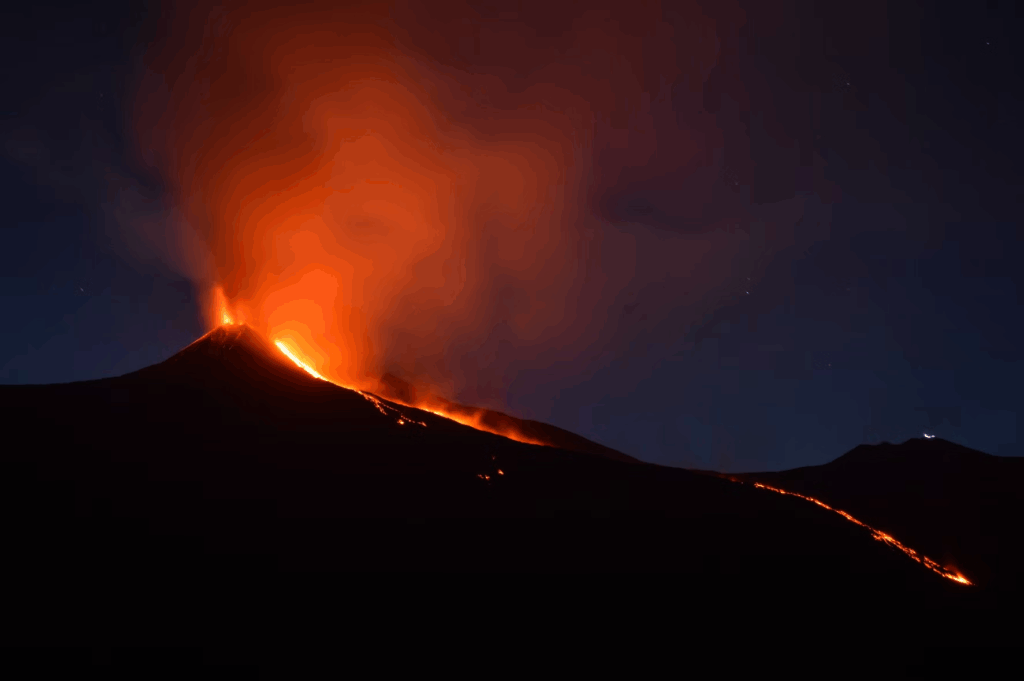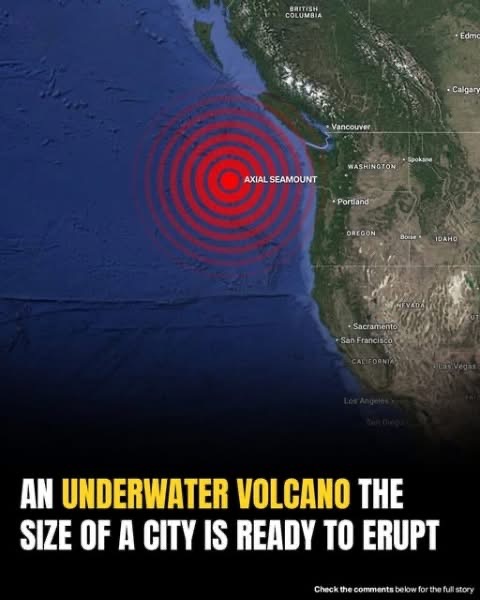Pacific Northwest Faces Deep Sea Fury: Undersea Volcano Inches Toward Eruption
According to geologists, a massive underwater volcano is displaying signals of an imminent eruption hundreds of miles off the coast of Oregon.
Nearly a mile (1.4 kilometers) below the surface, the volcano, called Axial Seamount, is situated on a geological hot zone where molten rock gushes rise from the Earth’s mantle and into the crust. On the seafloor, hotspot volcanoes are frequent. However, Axial Seamount is also situated on the Juan de Fuca Ridge, which is a region where two enormous tectonic plates—the Pacific and Juan de Fuca plates—are continuously separating, leading to a persistent increase in pressure beneath the surface of the earth.
Researchers at the National Science Foundation’s Ocean Observatories Initiative Regional Cabled Array, a facility run by the University of Washington that tracks Axial Seamount activity, have found that the frequency of earthquakes has recently increased dramatically as the volcano inflates with more and more magma, suggesting an eruption may be imminent.
“At the moment, there are a couple hundred earthquakes a day, but that’s still a lot less than we saw before the previous eruption,” said William Wilcock, a marine geophysicist and professor at the University of Washington School of Oceanography who studies the volcano.
“I would say it was going to erupt sometime later (this year) or early 2026, but it could be tomorrow, because it’s completely unpredictable,” he said.

What happens during an eruption?
The researchers saw over 10,000 small-scale tremors in a 24-hour period during the volcano’s most recent eruption in April 2015, and the next one should be no different, Wilcock said.
He stated that for a month, magma, or molten rock beneath the surface of the Earth, poured out of Axial Seamount and traveled roughly 25 miles (40 kilometers) across the seafloor.
A massive crater known as a caldera was formed when the magma chamber at the volcano’s center collapsed multiple times in the past. The mineral-rich gases that emerge via hydrothermal vents—which resemble underwater hot springs—are the source of life for the marine life there. White plumes known as “snowblowers” are produced when streams of heated fluid carrying billions of microorganisms and garbage clumps rise from fissures in the caldera’s surface.
“Lava flows scorched the small plants and animals on the hydrothermal vents during previous eruptions, but within three months, their ecosystem was back and flourishing again,” said Debbie Kelley, Regional Cabled Array director.
“I think it’s one of the biggest discoveries we’ve made,” said Kelley, a professor of marine geology and geophysics at the University of Washington, in a statement. “Life thrives in these inhospitable environments, and volcanoes are probably one of the major sources of life in our oceans.”
The heat and roar of seismic shifting may be felt by nearby marine life, including fish, whales, and octopuses, but they are not expected to suffer any harm. Additionally, Kelley told CNN, “People on land probably won’t notice the eruption at all.”
“It’s not a very explosive event. You won’t see the ash clouds above water, anything like that,” she said. “It’s like if you put a mile of seawater on top of Kilauea … you may see some fountaining, but that’s it.”
According to Kelley, the majority of the planet’s volcanic activity actually occurs in undersea spreading hubs like the Juan de Fuca Ridge, which sees many minor volcanic eruptions per day.
“The magma’s pretty close to the surface. It’s about a mile beneath the surface, which is very shallow compared with a lot of land volcanoes, where it may be 8 miles (12.9 kilometers) deep,” Kelley said, adding that the viscosity, or thickness, of the magma can affect how much pressure builds up in the magma chamber. Like a thick tomato sauce cooking on the stove, air bubbles within high-viscosity magma rupture more dramatically than Axial Seamount’s thinner, runnier magma.
How to watch
Fortunately, Axial Seamount is ideal for near human observation due to its relative mildness. “The observatory even plans to publicly livestream the event, which has never been done before, the next time the volcano erupts,” Kelley said.
It’s not easy to watch a volcanic explosion occur underwater. The first time scientists saw one in action firsthand was on April 29.
While conducting a routine submersible dive to gather data on the East Pacific Rise in the Pacific Ocean, approximately 1,300 miles (2,092 kilometers) west of Costa Rica, researchers affiliated with the Woods Hole Oceanographic Institution, or WHOI, noticed that the once-vibrant Tica vents were no longer teeming with marine life. Instead, according to WHOI Emeritus Research Scholar Dan Fornari, the team discovered a burnt “tubeworm barbeque.” An eruption was occurring as flashes of orange lava seeped through the seafloor and solidified in the icy water.
“It’s quite a significant development,” Fornari said. “It’s a very understudied environment, because it’s hard to reach and because we have to use clever technology to understand it. … At the heart of it, we are watching (the) ways in which this planet gets built, gets constructed by volcanism on the seafloor.”
As above, so below
Surprisingly, careful examination of the Axial Seamount has shown that the time of its eruption is related to both the above and the below-surface bubbling.
The three most recent eruptions, which took place in 1998, 2011, and 2015, all took place during the period between January and April, when the Earth is moving away from the sun.
“I don’t think we fully understand why that is, but it may be related to the (gravitational) forces from the moon influencing the volcano,” Wilcock said.
The moon’s monthly orbit around the Earth causes changes in seafloor pressure because of its gravitational attraction, which raises and lowers ocean tides. These pressure variations increase the strain on the caldera, the volcano’s crater formed by earlier eruptions, when the magma chamber reaches critical mass. According to Kelley, the chamber gradually reaches its breaking point due to the increased frequency of earthquakes brought on by the pressure of high tide.
Please SHARE this article with Family and Friends and let us know what you think in comments!






